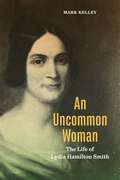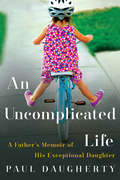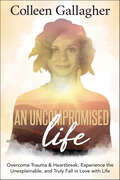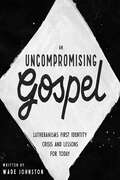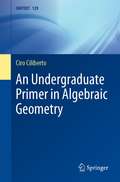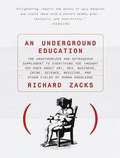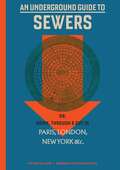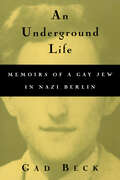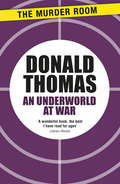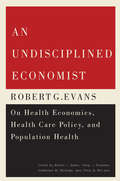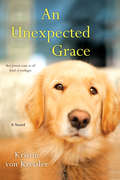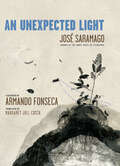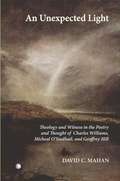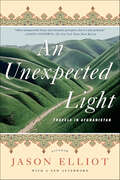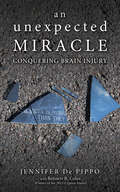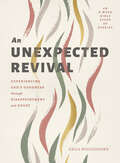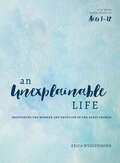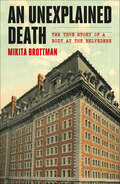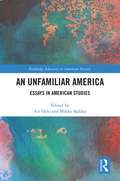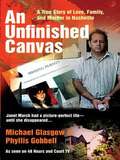- Table View
- List View
An Uncommon Woman: The Life of Lydia Hamilton Smith (Keystone Books)
by Mark KelleyLydia Hamilton Smith (1813–1884) was a prominent African American businesswoman in Lancaster, Pennsylvania, and the longtime housekeeper, life companion, and collaborator of the state’s abolitionist congressman Thaddeus Stevens. In his biography of this remarkable woman, Mark Kelley reveals how Smith served the cause of abolition, managed Stevens’s household, acquired property, and crossed racialized social boundaries.Born a free woman near Gettysburg, Smith began working for Stevens in 1844. Her relationship with Stevens fascinated and infuriated many, and it made Smith a highly recognizable figure both locally and nationally. The two walked side by side in Lancaster and in Washington, DC, as they worked to secure the rights of African Americans, sheltered people on the Underground Railroad, managed two households, raised her sons and his nephews, and built a real-estate business. In the last years of Stevens’s life, as his declining health threatened to short-circuit his work, Smith risked her own well-being to keep him alive while he led the drive to end slavery, impeach Andrew Johnson, and push for the ratification of the Thirteenth, Fourteenth, and Fifteenth Amendments.An Uncommon Woman is a vital history that accords Lydia Hamilton Smith the recognition that she deserves. Every American should know Smith’s inspiring story.
An Uncomplicated Life
by Paul DaughertyA father's exhilarating and inspiring love letter to his daughter with Down syndrome, whose vibrant and infectious approach can teach us all how to live a little better"Jillian was born October 17, 1989. It was the last bad day."Jillian Daugherty was born with Down syndrome. The day her parents, Paul and Kerry, brought her home from the hospital, they were flooded with worry and uncertainty, but also with overwhelming love, which they channeled to "the job of building the better Jillian." They knew their daughter had special needs, but they refused to have her grow up needy. They were resolved that Jillian's potential would not be limited by preconceptions of who she was or what she could be.In this charming and often heart-stirring book, Paul tells stories about Jillian making her way through the world of her backyard and neighborhood, going to school in a "normal" classroom, learning to play soccer and ride a bike. As she grows older, he traces her journey to find happiness and purpose in her adult life, including vignettes about her inspiring triumphs and the guardian angels--teachers, neighbors, friends--who believed in Jillian and helped her become the exceptional young woman she is today.In An Uncomplicated Life, the parent learns as much about life from the child as the child does from the parent. Being with Jillian, Paul discovered the importance of every moment and the power of the human spirit--how we are each put here to benefit the other. Through her unmitigated love for others, her sparkling charisma, and her boundless capacity for joy, Jillian has inspired those around her to live better and more fully. As Paul writes, "Jillian is a soul map of our best intentions," a model of grace, happiness, and infectious enthusiasm. She embraces all that she is, all that she has--"I love my life. I just love my life," she says. In her uncomplicated life, we see the possibility, the hope, and the beauty of our own.
An Uncompromised Life: Overcome Trauma and Heartbreak, Experience the Unexplainable, and Truly Fall in Love with Life
by Colleen GallagherAn Uncompromised Life empowers readers to overcome their heartbreaks and trauma, so that they can fall in love with life by understanding how to live a life which does not compromise their soul.An Uncompromised Life takes readers through Colleen Gallagher’s past unhealthy relationship which led her to compromise her soul. From this relationship, an unplanned pregnancy was created. Faced with a life changing decision, and shocked because Western medical doctors told Colleen it would be challenging for her to get pregnant after being diagnosed with cancer at age 14, she chose to let her child go. Through this difficult moment, the name Ella came to Colleen. The name Ella encouraged her to realize that her child was real and would always be with her in her heart. Colleen learned what it truly meant to fall in love with life, find herself, and find the power in living a life uncompromised to the soul. There are 12 lessons that she learned during her beautiful life journey that she has captured and written within An Uncompromised Life to share with readers, so they too can:Live to their fullest potential;Understand that miracles exist and will happen for them;Overcome any trauma that they have gone through; andKnow that they can create an impact-driven business to guide others in their souls’ evolution on this planet.
An Uncompromising Gospel: Lutheranism's First Identity Crisis and Lessons for Today
by Wade JohnstonMartin Luther with preached and written word unleashed the unconditional and uncompromising gospel of God's love for sinners in Jesus Christ, crucified and risen. He exposed both man's lost condition and Christ's unfathomable love with unrelenting persistence and unmistakable clarity. Bound in sin, only Christ could set the sinner free, and Luther held Christ before his students, hearers, and readers. That message marked and formed his students and coworkers, and yet after his death bitter disputes broke out about some of the most central aspects of his theology. Debates cut to the very heart of the Reformation, and this while its future hung precariously in the balance. An Uncompromising Gospel highlights Luther's key theological teachings, details the controversies that broke out over them after his death, and provides important lessons for our own day, as Christians still struggle to grasp and hold forth the love of Christ for sinners dead in trespasses and sins. As Lutheranism in specific and Christianity as a whole struggle to find and articulate their identity in challenging times yet once again, An Uncompromising Gospel provides helpful reminders about what the chief task and message of the church are and ought to be as it presses forward in God's grace and with the good news of Christ Jesus.
An Undergraduate Primer in Algebraic Geometry (UNITEXT #129)
by Ciro CilibertoThis book consists of two parts. The first is devoted to an introduction to basic concepts in algebraic geometry: affine and projective varieties, some of their main attributes and examples. The second part is devoted to the theory of curves: local properties, affine and projective plane curves, resolution of singularities, linear equivalence of divisors and linear series, Riemann–Roch and Riemann–Hurwitz Theorems.The approach in this book is purely algebraic. The main tool is commutative algebra, from which the needed results are recalled, in most cases with proofs. The prerequisites consist of the knowledge of basics in affine and projective geometry, basic algebraic concepts regarding rings, modules, fields, linear algebra, basic notions in the theory of categories, and some elementary point–set topology.This book can be used as a textbook for an undergraduate course in algebraic geometry. The users of the book are not necessarily intended to become algebraic geometers but may be interested students or researchers who want to have a first smattering in the topic. The book contains several exercises, in which there are more examples and parts of the theory that are not fully developed in the text. Of some exercises, there are solutions at the end of each chapter.
An Underground Education
by Richard ZacksThe best kind of knowledge is uncommon knowledge.Okay, so maybe you know all the stuff you're supposed to know--that there are teenier things than atoms, that Remembrance of Things Past has something to do with a perfumed cookie, that the Monroe Doctrine means we get to take over small South American countries when we feel like it. But really, is this kind of knowledge going to make you the hit of the cocktail party, or the loser spending forty-five minutes examining the host's bookshelves?Wouldn't you rather learn things like how the invention of the bicycle affected the evolution of underwear? Or that the 1949 Nobel Prize for Medicine was awarded to a doctor who performed lobotomies with a household ice pick? Or how Catherine the Great really died? Or that heroin was sold over the counter not too long ago?For the truly well-rounded "intellectual," nothing fascinates so much as the subversive, the contrarian, the suppressed, and the bizarre. Richard Zacks, auto-didact extraordinaire, has unloosed his admittedly strange mind and astonishing research abilities upon the entire spectrum of human knowledge, ferreting out endlessly fascinating facts, stories, photos, and images guaranteed to make you laugh, gasp in wonder, and occasionally shudder at the depths of human depravity. The result of his labors is this fantastically illustrated quasi-encyclopedia that provides alternative takes on art, business, crime, science, medicine, sex (lots of that), and many other facets of human experience.Immensely entertaining, and arguably enlightening, An Underground Education is the only book that explains the birth of motion pictures using photos of naked baseball players.Richard Zacks is the author of History Laid Bare: Love, Sex and Perversity from the Ancient Etruscans to Warren G. Harding, which was excerpted in classy magazines like Harper's and earned the attention of the even classier New York Times, which noted that "Zacks specializes in the raunchy and perverse." The Georgia State Legislature voted on whether to ban the book from public libraries. He has studied Arabic, Greek, Latin, French, Italian, and Hebrew, and received the Phillips Classical Greek Award at the University of Michigan. He has also told his publisher that he made a living in Cairo cheating royalty from a certain Arab country at games of chance, although the claim remains unverified. His writing has appeared in the New York Times, The Atlantic Monthly, Time, Life, Sports Illustrated, The Village Voice, TV Guide, and similarly diverse publications. Zacks is married and busy warping the minds of his two children, Georgia and Ziegfield. He resides in New York City, and can be reached via e-mail at rzacks@echonyc.com.From the Hardcover edition.
An Underground Guide to Sewers: or: Down, Through and Out in Paris, London, New York, &c.
by Stephen HallidayA global guide to sewers that celebrates the magnificently designed and engineered structures beneath the world's great cities. The sewer, in all its murkiness, filthiness, and subterranean seclusion, has been an evocative (and redolent) literary device, appearing in works by writers ranging from Charles Dickens to Graham Greene. This entertaining and erudite book provides the story behind, or beneath, these stories, offering a global guide to sewers that celebrates the magnificently designed and engineered structures that lie underneath the world's great cities. Historian Stephen Halliday leads readers on an expedition through the execrable evolution of waste management—the open sewers, the cesspools, the nightsoil men, the scourge of waterborne diseases, the networks of underground piping, the activated sludge, the fetid fatbergs, and the sublime super sewers. Halliday begins with sanitation in the ancient cities of Mesopotamia, Greece, and Imperial Rome, and continues with medieval waterways (also known as “sewage in the street”); the civil engineers and urban planners of the industrial age, as seen in Liverpool, Boston, Paris, London, and Hamburg; and, finally, the biochemical transformations of the modern city. The narrative is illustrated generously with photographs, both old and new, and by archival plans, blueprints, and color maps tracing the development of complex sewage systems in twenty cities. The photographs document construction feats, various heroics and disasters, and ingenious innovations; new photography from an urban exploration collective offers edgy takes on subterranean networks in cities including Montreal, Paris, London, Berlin, and Prague.
An Underground Life: Memoirs of a Gay Jew in Nazi Berlin (Living Out: Gay and Lesbian Autobiog)
by Gad Beck Frank HeibertThat a Jew living in Nazi Berlin survived the Holocaust at all is surprising. That he was a homosexual and a teenage leader in the resistance and yet survived is amazing. But that he endured the ongoing horror with an open heart, with love and without vitriol, and has written about it so beautifully is truly miraculous. This is Gad Beck’s story.
An Understdable Guide to Music Theory: The Most Useful Aspects of Theory for Rock, Jazz, and Blues Musicians
by Chaz BufeThis guide explains the most useful aspects of theory in clear, nontechnical language. Areas covered include scales (major, minor, modal, synthetic), chord formation, chord progression, melody, song forms, useful devices, (ostinato, mirrors, hocket, etc.), and instrumentation. It contains over 100 musical examples.
An Underworld at War: Spivs, Deserters, Racketeers and Civilians in the Second World War
by Donald ThomasThe Second World War produced numerous acts of self-sacrifice, but it also made many people rich. Under the cover of war, crime ranging from opportunistic looting to systematic theft was able to flourish.Donald Thomas draws on extensive archive material to reveal the ingenuity and sheer scale of wartime criminality, making fascinating reading of one of the great untold stories of the war.'A mesmerising, unputdownable and brilliantly researched page-turner' Sunday Times
An Underworld at War: Spivs, Deserters, Racketeers and Civilians in the Second World War (Murder Room #55)
by Donald ThomasThe Second World War produced numerous acts of self-sacrifice, but it also made many people rich. Under the cover of war, crime ranging from opportunistic looting to systematic theft was able to flourish.Donald Thomas draws on extensive archive material to reveal the ingenuity and sheer scale of wartime criminality, making fascinating reading of one of the great untold stories of the war.'A mesmerising, unputdownable and brilliantly researched page-turner' Sunday Times
An Undisciplined Economist: Robert G. Evans on Health Economics, Health Care Policy, and Population Health
by Kimberlyn M. Mcgrail Greg L. Stoddart Chris B. Mcleod Morris L. BarerFor four decades Robert Evans has been Canada's foremost health policy analyst and commentator, playing a leadership role in the development of both health economics and population health at home and internationally. An Undisciplined Economist collects sixteen of Evans's most important contributions, including two new articles. The topics addressed range widely, from the peculiar structure of the health care industry to the social determinants of the health of entire populations to the misleading role that economists have sometimes played in health policy debates. Written with Evans's characteristic clarity, candour, and wit, these essays unabashedly expose health policy myths and the special interests that lie behind them. He refutes claims that public health insurance is unsustainable, that the health care costs of an aging population will bankrupt Canada, that user charges will make the health care system more efficient, and that health care is the most important determinant of a population's health. An Undisciplined Economist is a valuable collection for those familiar with Evans's work, a lucid introduction for those new to the fields of health economics, health policy, and population health, and a fitting tribute to an outstanding scholar.
An Undisciplined Economist: Robert G. Evans on Health Economics, Health Care Policy, and Population Health (Carleton Library Series)
by Greg L. Stoddart Morris L. Barer Kimberlyn M. McGrail Chris B. McLeodFor four decades Robert Evans has been Canada’s foremost health policy analyst and commentator, playing a leadership role in the development of both health economics and population health at home and internationally. An Undisciplined Economist collects Evans’ most important contributions and includes two new articles. The topics addressed range widely, from the peculiar structure of the health care industry to the social determinants of the health of entire populations to the misleading role that economists have sometimes played in health policy debates. Written with Evans' characteristic clarity, candour, and wit, these essays unabashedly expose health policy myths and the special interests that lie behind them. He refutes claims that public health insurance is unsustainable, that the health care costs of an aging population will bankrupt Canada, that user charges will make the health care system more efficient, and that health care is the most important determinant of a population’s health. An Undisciplined Economist is a valuable collection for those familiar with Evans’ work, a lucid introduction for those new to the fields of health economics, health policy, and population health, and a fitting tribute to an outstanding scholar.
An Unexpected Grace
by Kristin von KreislerIn this uplifting novel, a woman recovering from trauma finds compassion and connection with a rescue dog as they help each other overcome fear.Lila Elliot knows she's lucky to be alive. A shooting rampage at her office left several colleagues dead and others seriously wounded. Though Lila's injuries will heal in time, she's having trouble moving past her fear and anger. Being drafted into caring for Grace—a shaggy, formerly abused golden retriever—only adds to her stress. Lila has been terrified of dogs since childhood. But Grace, like Lila, needs time and space to recover.Grace keeps her distance, sensing Lila's wariness, and only perks up for Adam, the neighbor who rescued her. But as an accomplished artist, Lila begins to see the beauty in Grace's wisps of fur and haunted eyes. Each of them has suffered through no fault of her own. And in helping Grace to trust, Lila begins to develop the courage she needs to do the same.Includes reading group guide
An Unexpected Light
by José SaramagoNobel Prize winner José Saramago tells a quiet and poetic story, an excerpt from his book Small Memories, of a lasting childhood experience of simple, soulful joy.The narrator's memories of a lost childhood paradise focus on two glorious days when he helped his uncle take some piglets to the market in Santarém. They traverse dusty roads, sleep in a barn and awake to a miraculous moonglow, and hear the animals in their &“infinite conversations.&” The journey, the night, the wind, the light. . . . This poetic story is an unforgettable adventure narrated by José Saramago and presented alongside Armando Fonseca&’s fanciful and evocative illustrations.A very special gift for readers of all ages.
An Unexpected Light: Theology And Witness In The Poetry Of Charles Williams, Micheal O'Siadhail, And Geoffrey Hill
by Ben Quash David C. MahanA growing number of professional theologians today seek to push theological inquiry beyond the relative seclusion of academic specialization into a broader marketplace of public ideas, and to recast the theological task as an integrative discipline, wholly engaged with the issues and sensibilities of the age. <P><P>Accordingly, such scholars seek to draw upon and engage the insights and practices of a variety of cultural resources, including those of the arts, in their theological projects. Arguing that poetry can be a form of theological discourse, Mahan shows how poetry offers rich theological resources and instruction for the Christian church. <P><P>In drawing attention to the peculiar advantages it affords, this book addresses one of the greatest challenges facing the church today: the difficulty of effectively communicating the Christian gospel with increasingly disaffected late-modern people.
An Unexpected Light: Travels in Afghanistan
by Jason ElliotPart historical evocation, part travelogue, and part personal quest, An Unexpected Light is the account of Elliot's journey through Afghanistan, a country considered off-limits to travelers for twenty years. Aware of the risks involved, but determined to explore what he could of the Afghan people and culture, Elliot leaves the relative security of Kabul. He travels by foot and on horseback, and hitches rides on trucks that eventually lead him into the snowbound mountains of the North toward Uzbekistan, the former battlefields of the Soviet army's "hidden war." Here the Afghan landscape kindles a recollection of the author's life ten years earlier, when he fought with the anti-Soviet mujaheddin resistance during the Soviet occupation of Afghanistan. Weaving different Afghan times and visits with revealing insights on matters ranging from antipersonnel mines to Sufism, Elliot has created a narrative mosaic of startling prose that captures perfectly the powerful allure of a seldom-glimpsed world. Jason Elliot's An Unexpected Light is a remarkable, poignant book about Afghanistan and a heartfelt reflection on the experience of travel itself.
An Unexpected Miracle
by Jennifer De PippoThree days before her eighth birthday, Jennifer De Pippo was nearly killed in a car accident which claimed the life of her mother and left her with brain injuries so severe that the doctors said she would never walk or talk again. Join Jennifer as she describes the highs and lows of her life-long struggle to prove the doctors wrong, and to rebuild herself into a functioning, fun-loving and fast-thinking adult.Through sheer determination, Jennifer has succeeded in achieving what was considered impossible, turning every day of her life into an unexpected miracle.
An Unexpected Revival: Experiencing God's Goodness through Disappointment and Doubt- An 8-week Bible Study of Ezekiel
by Erica WiggenhornDo you long to feel a closer connection to God? To discern His voice, experience His peace, and live in His joy? In this 8-week Bible study, An Unexpected Revival: Experiencing God&’s Goodness through Disappointment and Doubt, you will encounter a unique picture of revival through Ezekiel&’s prophecies. God chose to spark revival through people who seemed counted out, cast aside, and disregarded. Ezekiel reveals that we are not the first people to believe our doubts and doubt our beliefs when circumstances spiral out of control. But God pursues us with His goodness desiring to bring revival to our broken hearts. Through a study of the book of Ezekiel, God offers an invitation to: — experience His faithfulness when surrounded by uncertainty— reignite our hope instead of losing heart— realize the call of God, reawakening us to our purpose— rest in contentment rather than dwell in disappointment An Unexpected Revival sparks a fire in our longing heart to feel renewed excitement in our relationship with God. Instead of going through the motions, checking the boxes and wondering why God feels so far away, Ezekiel teaches us to come close and invite God to fill us with fresh fire. God offers His joy, peace, and purpose to any who seek it. Do you long for revival?This 8-week study will also include video teaching through Vimeo.
An Unexpected Revival: Experiencing God's Goodness through Disappointment and Doubt- An 8-week Bible Study of Ezekiel
by Erica WiggenhornDo you long to feel a closer connection to God? To discern His voice, experience His peace, and live in His joy? In this 8-week Bible study, An Unexpected Revival: Experiencing God&’s Goodness through Disappointment and Doubt, you will encounter a unique picture of revival through Ezekiel&’s prophecies. God chose to spark revival through people who seemed counted out, cast aside, and disregarded. Ezekiel reveals that we are not the first people to believe our doubts and doubt our beliefs when circumstances spiral out of control. But God pursues us with His goodness desiring to bring revival to our broken hearts. Through a study of the book of Ezekiel, God offers an invitation to: — experience His faithfulness when surrounded by uncertainty— reignite our hope instead of losing heart— realize the call of God, reawakening us to our purpose— rest in contentment rather than dwell in disappointment An Unexpected Revival sparks a fire in our longing heart to feel renewed excitement in our relationship with God. Instead of going through the motions, checking the boxes and wondering why God feels so far away, Ezekiel teaches us to come close and invite God to fill us with fresh fire. God offers His joy, peace, and purpose to any who seek it. Do you long for revival?This 8-week study will also include video teaching through Vimeo.
An Unexplainable Life: Recovering the Wonder and Devotion of the Early Church (Acts 1-12)
by Erica WiggenhornWhat can God do with fifty days?In only fifty days Peter was radically transformed. He went from being a man in the shadows denying even knowing Jesus, to a man boldly proclaiming the resurrection of Jesus in the middle of the temple courts. How did the change occur? And more importantly, can such a change occur within us—today, in the here and now?For fifty days, I invite you to dwell in the first twelve chapters of Acts. Here we meet Peter face-to-face and encounter the source of his power. We become challenged to grab hold of that power ourselves, believing that God wants to do something in and through us that is unexplainable apart from Him. Let&’s give God fifty days and see what He might do.The purpose of this study isn&’t simply to reiterate a message. (You can find many studies on Acts.) Our purpose is to reignite a movement of the power of the Holy Spirit in each of us individually and in our churches collectively. Are you ready? — Erica WiggenhornParticipants will enjoy:A verse-by-verse study spread over ten weeks (5 lessons/week)Many biblical, theological, and historical insightsText-based discussion questions that truly provoke thought
An Unexplainable Life: Recovering the Wonder and Devotion of the Early Church (Acts 1-12)
by Erica WiggenhornWhat can God do with fifty days?In only fifty days Peter was radically transformed. He went from being a man in the shadows denying even knowing Jesus, to a man boldly proclaiming the resurrection of Jesus in the middle of the temple courts. How did the change occur? And more importantly, can such a change occur within us—today, in the here and now?For fifty days, I invite you to dwell in the first twelve chapters of Acts. Here we meet Peter face-to-face and encounter the source of his power. We become challenged to grab hold of that power ourselves, believing that God wants to do something in and through us that is unexplainable apart from Him. Let&’s give God fifty days and see what He might do.The purpose of this study isn&’t simply to reiterate a message. (You can find many studies on Acts.) Our purpose is to reignite a movement of the power of the Holy Spirit in each of us individually and in our churches collectively. Are you ready? — Erica WiggenhornParticipants will enjoy:A verse-by-verse study spread over ten weeks (5 lessons/week)Many biblical, theological, and historical insightsText-based discussion questions that truly provoke thought
An Unexplained Death: The True Story of a Body at the Belvedere
by Mikita BrottmanAn Unexplained Death is an obsessive investigation into a mysterious death at the Belvedere—a once-grand hotel—and a poignant, gripping meditation on suicide and voyeurism“The poster is new. I notice it right away, taped to a utility pole. Beneath the word ‘Missing,’ printed in a bold, high-impact font, are two sepia-toned photographs of a man dressed in a bow tie and tux.” Most people would keep walking. Maybe they’d pay a bit closer attention to the local news that evening. Mikita Brottman spent ten years sifting through the details of the missing man’s life and disappearance, and his purported suicide by jumping from the roof of her own apartment building, the Belvedere. As Brottman delves into the murky circumstances surrounding Rey Rivera’s death—which begins to look more and more like a murder—she contemplates the nature of and motives behind suicide, and uncovers a haunting pattern of guests at the Belvedere, when it was still a historic hotel, taking their own lives on the premises. Finally, she fearlessly takes us to the edge of her own morbid curiosity and asks us to consider our own darker impulses and obsessions.
An Unfamiliar America: Essays in American Studies (Routledge Advances in American History #18)
by Ari Helo and Mikko SaikkuThis collection focuses on conceptions of the unfamiliar from the viewpoint of mainstream American history: aliens, immigrants, ethnic groups, and previously unencountered ideas and ideologies in Trumpian America. The book suggests bringing historical thinking back to the center of American Studies, given that it has been recently challenged by the influential memory studies boom. As much as identity-building appears to be the central concern for much of the current practice in American history writing, it is worth keeping in mind that historical truth may not always directly contribute to one's identity-building. The researcher’s constant quest for truth does not equate to already possessing it. History changes all the time, because it consists of our constant reinterpretation of the past. It is only the past that does not change. This collection aims at keeping these two apart, while scrutinizing a variety of contested topics in American history, from xenophobic attitudes toward eighteenth-century university professors, Apache masculinity, Ku Klux Klan, Tom Waits's lyrics, and the politics of the Trump era.
An Unfinished Canvas: A True Story of Love, Family, and Murder in Nashville
by Phyllis Gobbell Michael GlasgowJanet March had a picture-perfect life-until she disappeared... No body, no cause of death, no physical evidence-and yet, after ten years, a murder conviction... <P> Janet March, the strikingly attractive artist and wife of corporate lawyer Perry March, had it all: two children she adored, a burgeoning career in the arts, supportive parents, and a dream house. What no one knew was that her husband led a destructive double life of secrets and lies. On August 16, 1996, Janet would finally file for divorce. But she never made it to that appointment-because on August 15, she vanished... <P> Janet's disappearance incited a massive search and media frenzy, revealing Perry's true nature to the world. For ten years, her parents and Perry battled each other through the court system in what would become and international custody battle. Meanwhile, the Nashville Police Department investigated the case from every possible angle, with the eventual help of a shocking surprise witness. Though they couldn't find the body, determine the cause of death, or even reconstruct exactly what happened that fateful night, her parents and Nashville's first Cold Case Squad remained certain of one thing-they would find justice for Janet.
